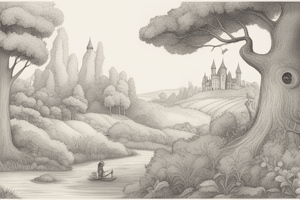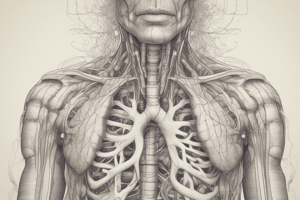Podcast
Questions and Answers
What are the functions of the respiratory system?
What are the functions of the respiratory system?
The respiratory system works with the circulatory system to provide oxygen and to remove waste products of metabolism. It also helps to regulate the pH of the blood.
What is external respiration?
What is external respiration?
External respiration involves the exchange of oxygen and carbon dioxide between the lungs and blood.
What is internal respiration?
What is internal respiration?
Internal respiration involves the exchange of gases between the blood and tissue cells.
What structures are located in the upper respiratory tract?
What structures are located in the upper respiratory tract?
What structures are located in the lower respiratory tract?
What structures are located in the lower respiratory tract?
The ____ cavity is the interior chamber of the nose.
The ____ cavity is the interior chamber of the nose.
The ____ divide the nose into two parts.
The ____ divide the nose into two parts.
What is the difference between the hard palate and soft palate?
What is the difference between the hard palate and soft palate?
What are the functions of the nasal conchae?
What are the functions of the nasal conchae?
What are the paranasal sinuses?
What are the paranasal sinuses?
What is the function of the mucus secreted by the mucous membrane of the nose?
What is the function of the mucus secreted by the mucous membrane of the nose?
What is the function of the cilia in the nasal cavity?
What is the function of the cilia in the nasal cavity?
What is the nasopharynx?
What is the nasopharynx?
What is the function of the eustachian tubes?
What is the function of the eustachian tubes?
What is the oropharynx?
What is the oropharynx?
What is the laryngopharynx?
What is the laryngopharynx?
What is the layman's term for the thyroid cartilage?
What is the layman's term for the thyroid cartilage?
What is the function of the epiglottis?
What is the function of the epiglottis?
What is the glottis?
What is the glottis?
What holds the trachea open?
What holds the trachea open?
Describe the components of the bronchial tree.
Describe the components of the bronchial tree.
Why do the walls of the alveolar ducts and alveoli consist of simple squamous epithelium?
Why do the walls of the alveolar ducts and alveoli consist of simple squamous epithelium?
Why are the lungs soft and spongy?
Why are the lungs soft and spongy?
How does the right lung differ in appearance from the left lung?
How does the right lung differ in appearance from the left lung?
What is the pleura?
What is the pleura?
What is another name for breathing?
What is another name for breathing?
What is included in one breath?
What is included in one breath?
How does air move into the lungs during inhalation?
How does air move into the lungs during inhalation?
How does air move out of the lungs during exhalation?
How does air move out of the lungs during exhalation?
Where is the respiratory center located?
Where is the respiratory center located?
What happens if there is an increase in carbon dioxide in the blood?
What happens if there is an increase in carbon dioxide in the blood?
What are examples of nonrespiratory air movements?
What are examples of nonrespiratory air movements?
Cartilage in the walls of the trachea and bronchi undergoes ____ due to aging.
Cartilage in the walls of the trachea and bronchi undergoes ____ due to aging.
Bronchioles are replaced by ____ tissue and are less able to stretch and contract due to aging.
Bronchioles are replaced by ____ tissue and are less able to stretch and contract due to aging.
With aging, alveoli lose some ____ recoil and walls deteriorate between adjacent alveoli.
With aging, alveoli lose some ____ recoil and walls deteriorate between adjacent alveoli.
Flashcards
External Respiration
External Respiration
Gas exchange between the lungs and blood.
Internal Respiration
Internal Respiration
Gas exchange between blood and body tissues.
Upper Respiratory Tract
Upper Respiratory Tract
Nose, pharynx, and larynx.
Lower Respiratory Tract
Lower Respiratory Tract
Signup and view all the flashcards
Nasal Cavity
Nasal Cavity
Signup and view all the flashcards
Nasal Septum
Nasal Septum
Signup and view all the flashcards
Nostrils
Nostrils
Signup and view all the flashcards
Internal Nares
Internal Nares
Signup and view all the flashcards
Palate
Palate
Signup and view all the flashcards
Uvula
Uvula
Signup and view all the flashcards
Hard Palate
Hard Palate
Signup and view all the flashcards
Soft Palate
Soft Palate
Signup and view all the flashcards
Nasal Conchae
Nasal Conchae
Signup and view all the flashcards
Paranasal Sinuses
Paranasal Sinuses
Signup and view all the flashcards
Mucus
Mucus
Signup and view all the flashcards
Cilia
Cilia
Signup and view all the flashcards
Pharynx Sections
Pharynx Sections
Signup and view all the flashcards
Larynx
Larynx
Signup and view all the flashcards
Epiglottis
Epiglottis
Signup and view all the flashcards
Glottis
Glottis
Signup and view all the flashcards
Trachea
Trachea
Signup and view all the flashcards
Bronchial Tree
Bronchial Tree
Signup and view all the flashcards
Alveoli
Alveoli
Signup and view all the flashcards
Lungs
Lungs
Signup and view all the flashcards
Pleura
Pleura
Signup and view all the flashcards
Study Notes
Functions of the Respiratory System
- Provides oxygen and removes metabolic waste products in conjunction with the circulatory system.
- Regulates blood pH levels.
External and Internal Respiration
- External respiration: Exchange of oxygen and carbon dioxide between the lungs and blood.
- Internal respiration: Exchange of gases between blood and tissue cells.
Respiratory Tract Structures
- Upper respiratory tract: Comprises the nose, pharynx, and larynx.
- Lower respiratory tract: Includes the trachea, bronchial tree, and lungs.
Components of the Nose
- Nasal cavity: The interior chamber allowing air passage.
- Nasal septum: Divides the nasal cavity into two halves.
- Nostrils: Entrance points for air into the nasal cavity.
- Internal nares: Openings from nasal cavity to the pharynx.
- Palate: Separates nasal and oral cavities, with hard and soft components.
- Uvula: Soft tissue that hangs at the back of the throat.
Nasal Structures and Functions
- Hard palate: Bony structure; the soft palate is unsupported by bone.
- Nasal conchae: Increase surface area for warming and moistening air; assist in airflow direction and trap particles in mucous.
Paranasal Sinuses
- Air-filled cavities located in the frontal, maxillae, ethmoid, and sphenoid bones.
- Functions include reducing skull weight, producing mucus, and influencing voice resonance.
Mucous Membrane and Cilia
- Mucus: Moistens, warms, and filters air entering the nasal cavity.
- Cilia: Propel mucus with trapped particles toward the pharynx for swallowing.
Pharynx Sections
- Nasopharynx: Located posterior to the nasal cavity.
- Oropharynx: Located posterior to the oral cavity; receives food, water, and air.
- Laryngopharynx: Most inferior portion, leading to the esophagus.
Larynx and Vocal Cords
- Thyroid cartilage: Commonly known as the Adam's apple.
- Epiglottis: Flap covering the larynx to prevent food and water entry during swallowing.
- False vocal cords: Protect the airway; true vocal cords: Involved in sound production.
- Glottis: The opening between true vocal cords leading to the trachea.
Trachea and Bronchial Tree
- Trachea supported by C-shaped hyaline cartilage for structural integrity.
- Bronchial tree: Composed of bronchi, bronchioles, and alveoli.
Alveolar Structure
- Alveolar ducts and alveoli feature simple squamous epithelium for rapid gas diffusion (oxygen and carbon dioxide exchanges).
Lung Anatomy
- Lungs are soft and spongy, primarily composed of air spaces and elastic tissue.
- Right lung: Shorter, broader with three lobes; left lung: two lobes.
Pleura and Breathing Mechanics
- Pleura: Double-layered membrane enclosing the lungs.
- Breathing (pulmonary ventilation): One inhalation and exhalation cycle.
Air Pressure Dynamics
- Air moves into lungs during inhalation due to lower internal pressure compared to the outside.
- During exhalation, air flows out until internal pressure equals external pressure.
Respiratory Control Centers
- Located in the pons and medulla oblongata of the brain stem.
- Increased carbon dioxide triggers an elevation in breathing rate and depth.
Nonrespiratory Air Movements
- Includes sneezing, coughing, sighing, hiccupping, crying, laughing, and yawning.
Effects of Aging on the Respiratory System
- Cartilage: Gradual calcification.
- Bronchioles: Replacement with fibrous tissue, reducing elasticity.
- Alveoli: Loss of elastic recoil and deterioration of walls between alveoli.
Studying That Suits You
Use AI to generate personalized quizzes and flashcards to suit your learning preferences.




